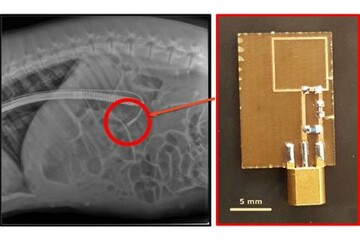New Biosensor Could Deliver Drugs, Monitor Vitals and Last Indefinitely Inside the Body
CAMBRIDGE, MA – Ingestible biosensors that can reside in the body for long periods of time hold the promise of radically transforming drug delivery and clinical treatment and evaluation. Such devices could be used to sense conditions in hard to reach places, like the gastrointestinal tract, or carry small reservoirs of drugs to be delivered over an extended period.
But the challenge of how to power these implantable devices has stymied researchers because of the difficulty in finding a safe and efficient power source.
Batteries have proven to be incompatible with the mucosal lining of the gastrointestinal tract and have a limited lifespan within the body. Near-field wireless transmission, which has been used in cochlear implants, requires a distance between two antennas—one inside the body, one outside—proportional to their diameters, that is too limited in range.
Researchers at Draper, MIT and Brigham and Women’s Hospital approached this challenge by demonstrating that a novel remote-charging method called midfield transmission could be relevant to in-vivo applications. Power from an antenna outside the body is transmitted to another antenna inside the digestive tract, yielding enough power to run sensors that can monitor heart rate, temperature and levels of particular nutrients or gases in the stomach. It can also provide power to sensors that serve as drug delivery vehicles and that can remain in the digestive tract for weeks or months.
The research, conducted on a pig, was recently published in the journal Scientific Reports.
“Ingestible biosensors hold great promise for a range of applications and could only have come about because of advancements in subthreshold electronics, low-power systems-on-a-chip and novel packaging miniaturization,” said Brian Smith, co-author on the paper and principal member of the technical staff at Draper.
Draper’s bioelectronics devices build on expertise developed over many years. Draper’s component-level innovations include zero-power and energy-scavenging Microelectromechanical Systems (MEMS) sensors, RF antennas that operate near the fundamental limits of efficiency versus size, smart antennas that adapt to environmental detuning and novel materials to enable lower-loss RF passives. Newer efforts strive to address fundamental limits, such as a program in which Draper will develop litz wire for RF inductors by braiding submicron-scale wires using a self-assembly and directed assembly process exploiting the specific binding properties of organic molecules.
Released May 2, 2017

